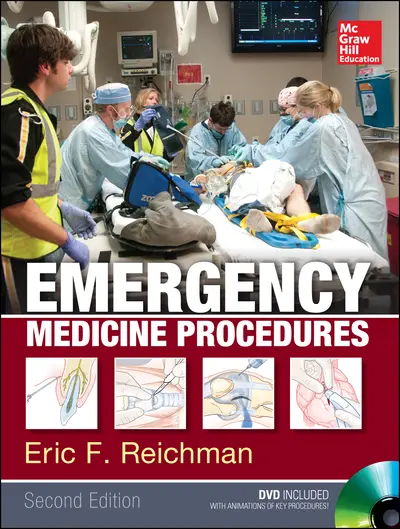My Account Details

ISBN10: 007161351X | ISBN13: 9780071613514

Step 1 . Download Adobe Digital Editions to your PC or Mac desktop/laptop.
Step 2. Register and authorize your Adobe ID (optional). To access your eBook on multiple devices, first create an Adobe ID at account.adobe.com. Then, open Adobe Digital Editions, go to the Help menu, and select "Authorize Computer" to link your Adobe ID.
Step 3. Open Your eBook. Use Adobe Digital Editions to open the file. If the eBook doesn’t open, contact customer service for assistance.
THE MOST CLEAR, COMPLETE, AND EASY-TO-UNDERSTAND REVIEW OF EMERGENCY MEDICINE PROCEDURES AVAILABLE
Going far beyond the scope of most other texts, this lavishly illustrated, expert-authored reference helps you master the clinical and technical skills required to perform the full range of procedures in an emergency or acute care setting. The techniques presented in these pages will dramatically expand your understanding of emergency medicine procedures and--most importantly--your ability to deliver positive patient outcomes.
FEATURES
- Over 1,700 original, precise illustrations
- Sections organized by procedures for each body region
- Each chapter focuses on a single procedure and oftenincludes several proven methods for performing it
- Chapters include:
- Relevant anatomy and pathophysiology
- Indications and contraindications for the procedure
- Preparation of the patient, including consent,anesthesia, and analgesia
- Step-by-step description of the procedure
- Cautions that indicate common problems
- Alternative techniques and helpful hints
- Aftercare and follow-up
- Potential complications
- Summary of critical information
- Includes both common procedures and infrequently encountered procedures
- Important evidence-based recommendations throughout
- Helpful pedagogy--includes key information, cautions, and important facts highlighted in bold
- Companion DVD with animations of the 20 most common or difficult procedures, and complete references for each chapter
1.Informed Consent
2.Aseptic Technique
3.Basic Principles of Ultrasonography
4.Ultrasound Assisted Procedures
5.Trauma Ultrasound: The FAST Scan
Section Two: Respiratory Procedures
6.Essential Anatomy of the Airway
7.Basic Airway Management
8.Pharmacologic Adjuncts to Intubation
9.Endotracheal Medication Administration
10.Rapid Sequence Induction
11.Orotracheal Intubation
12.Confirmation of Endotracheal Intubation
13.Video Assisted Orotracheal Intubation Devices
14.Fiberoptic Assisted Endotracheal Intubation Devices
15.Endotracheal Tube Intubating Introducers and Bougies
16.Digital (Tactile) Orotracheal Intubation
17.Lighted Stylet & Trachlight Intubation
18.Supraglottic Airway Devices
19.Laryngeal Mask Airways
20.Double Lumen Airway Tube Intubation
21.Fiberoptic Endoscopic Intubation
22.Nasotracheal Intubation
23.Retrograde Guidewire Intubation
24.Percutaneous Transtracheal Jet Ventilation
25.Cricothyroidotomy
26.Tracheostomy
27.Tracheostomy Care
28.Transtracheal Aspiration
Section Three: Cardiothoracic Procedures
29.Cardiac Ultrasound
30.Cardioversion and Defibrillation
31.Transcutaneous Cardiac Pacing
32.Transthoracic Cardiac Pacing
33.Transvenous Cardiac Pacing
34.Pacemaker Assessment
35.Automatic Implantable Cardioverter-Defibrillator Assessment
36.Pericardiocentesis
37.Intracardiac Injection
38.Needle Thoracostomy
39.Tube Thoracostomy
40.Thoracentesis
41.Open Chest Wound Management
42.Emergency Department Thoracotomy
43.Open Cardiac Massage
44.Cardiac Wound Repair
45.Hilum & Great Vessel Wound Management
46.Thoracic Aortic Occlusion
Section Four: Vascular Procedures
47.General Principles for Intravenous Access
48.Venipuncture and Peripheral Intravenous Access
49.Central Venous Access
50.Ultrasound Guided Vascular Access
51.Troubleshooting Indwelling Central Venous Lines
52.Accessing Indwelling Central Venous Lines
53.Pulmonary Artery (Swan-Ganz) Catheterization
54.Peripheral Venous Cutdown
55.Intraosseous Infusion
56.Umbilical Vessel Catheterization
57.Arterial Puncture and Cannulation
Section Five: Gastrointestinal Procedures
58.Nasogastric Intubation
59.Activated Charcoal Administration
60.Gastric Lavage
61.Whole Bowel Irrigation
62.Esophageal Foreign Body Removal
63.Balloon Tamponade of Gastrointestinal Bleeding
64.Gastrostomy Tube Replacement
65.Paracentesis
66.Diagnostic Peritoneal Lavage
67.Anal Fissure Management
68.External Hemorrhoid Management
69.Prolapsed Rectum Reduction
70.Anoscopy
71.Rigid Rectosigmoidoscopy
72.Rectal Foreign Body Extraction
Section Six: Orthopedic and Musculoskeletal Procedures
73.Bursitis and Tendonitis Therapy
74.Compartment Pressure Measurement
75.Fasciotomy
76.Extensor Tendon Repair
77.Arthrocentesis
78.Methylene Blue Joint Injection
79.Basic Principles of Fracture and Joint Reductions
80.Sternoclavicular Joint Dislocation Reduction
81.Shoulder Joint Dislocation Reduction
82.Elbow Joint Dislocation Reduction
83.Radial Head Subluxation (Nursemaids Elbow) Reduction
84.Metacarpophalangeal joint dislocation reduction
85.Interphalangeal Joint Dislocation Reduction
86.Hip Joint Dislocation Reduction
87.Patellar Dislocation Reduction
88.Knee Joint Dislocation Reduction
89.Ankle Joint Dislocation Reduction
90.Common Fracture Reduction
91.Casts and Splints
Section Seven:
Need support? We're here to help - Get real-world support and resources every step of the way.